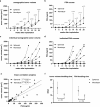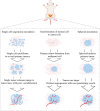Tumor promoting effect of spheroids in an orthotopic prostate cancer mouse model
- PMID: 38632341
- PMCID: PMC11024136
- DOI: 10.1038/s41598-024-59052-0
Tumor promoting effect of spheroids in an orthotopic prostate cancer mouse model
Abstract
In this study, we aimed to establish a technique for intraprostatic implantation of prostate cancer (PCa) spheroids and to identify the impact of three-dimensional organization of PCa cells on tumor progression and metastasis in a representative in vivo model. 40,000 LNCaP cells were implanted into the prostate of immunodeficient SCID mice either as single cells (n = 8) or as preformed 3D spheroids (n = 8). For a follow up of 20 weeks, tumor growth was monitored by serum PSA and high-resolution 3D ultrasonography. Eventually, animals were sacrificed and autopsied. The organ dissects were analyzed for the presence of metastases by histology (H&E) and immunohistochemistry (AMACR, AR, Ki-67, CK5, CK8, E-Cadherin, Vimentin). Solid intraprostatic tumors developed in 50% of mice after spheroid implantation and in 50% of mice after implantation of a single cells. Primary tumors of LNCaP spheroids evolved earlier, exhibiting a shorter tumor doubling time whilst developing larger tumor volumes, which was reflected by a higher immunohistochemical expression of Ki-67 and AR, too. Spheroid tumors established lung and lymph node metastases in 75% of mice, in contrast to 50% of mice after single cell implantation. Our technique enables a variety of studies regarding the influence of the tumor microenvironment on PCa progression.
© 2024. The Author(s).
Conflict of interest statement
The authors declare no competing interests.
Figures








Similar articles
-
A novel mouse model of human prostate cancer to study intraprostatic tumor growth and the development of lymph node metastases.Prostate. 2018 Jun;78(9):664-675. doi: 10.1002/pros.23508. Epub 2018 Mar 24. Prostate. 2018. PMID: 29572953
-
A metastatic and androgen-sensitive human prostate cancer model using intraprostatic inoculation of LNCaP cells in SCID mice.Cancer Res. 1997 Apr 15;57(8):1584-9. Cancer Res. 1997. PMID: 9108464
-
Cancer-associated fibroblasts stimulate primary tumor growth and metastatic spread in an orthotopic prostate cancer xenograft model.Sci Rep. 2020 Jul 28;10(1):12575. doi: 10.1038/s41598-020-69424-x. Sci Rep. 2020. PMID: 32724081 Free PMC article.
-
Establishing human prostate cancer cell xenografts in bone: induction of osteoblastic reaction by prostate-specific antigen-producing tumors in athymic and SCID/bg mice using LNCaP and lineage-derived metastatic sublines.Int J Cancer. 1998 Sep 11;77(6):887-94. doi: 10.1002/(sici)1097-0215(19980911)77:6<887::aid-ijc15>3.0.co;2-z. Int J Cancer. 1998. PMID: 9714059
-
[Biological behavior of prostate cancer cells in 3D culture systems].Yakugaku Zasshi. 2008 Jan;128(1):37-44. doi: 10.1248/yakushi.128.37. Yakugaku Zasshi. 2008. PMID: 18176054 Review. Japanese.
Cited by
-
Assessing metabolic alterations and cancer biomarkers in athymic nude mice implanted with NSCLC spheroids.Metabolomics. 2025 Jun 11;21(4):77. doi: 10.1007/s11306-025-02274-8. Metabolomics. 2025. PMID: 40498414 Free PMC article.
References
-
- Nowossadeck E, Kowalski C, Barnes B. Demografische Alterung und Krebs. Onkologie heute. 2018;3:48–50.
MeSH terms
Substances
LinkOut - more resources
Full Text Sources
Medical
Research Materials
Miscellaneous

